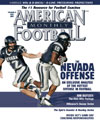AMERICAN FOOTBALL MONTHLY THE #1 RESOURCE FOR FOOTBALL COACHES
Article CategoriesAFM Magazine
|
Giving Your Quarterback the Advantage© More from this issueQuarterback Training & Development’s obligation to offensive skilled position players is to teach them the skills and techniques that give them a chance to succeed against players who are better than they are. We recently received the following email from one of our players: “Hey coach, the camp went really well. We did 1 on 1 drills which built my confidence because I found out that I could definitely play with some of the best.” This is a necessary part of competing at any level. At some point there will be a mismatch and if your player can take advantage of the situation, he can win. The only things that earn a player’s respect and confidence in you as a coach are teaching him the techniques and skills that work (and give him a chance to win) and making sure he understands why you teach such techniques, skills and decisio....The full article can only be seen by subscribers. Subscribe today!
|
|
|||||||
| HOME |
MAGAZINE |
SUBSCRIBE | ONLINE COLUMNISTS | COACHING VIDEOS |
Copyright 2025, AmericanFootballMonthly.com
All Rights Reserved





